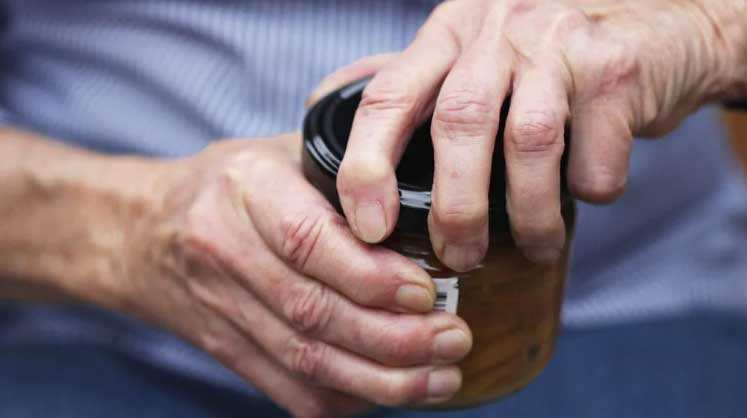
There is no known cure for arthritis, which commonly affects the hands. However, a person can take steps to lower the risk of arthritis developing or worsening and to reduce and manage pain. These steps include practicing specific exercises and making dietary changes and adjustments to daily habits.
Arthritis is a general term that describes several conditions that affect a person’s joints. There are more than 100 different types of arthritis. Arthritis is generally not preventable, but a person may be able to reduce their risk by changing the risk factors that they can control.
According to the Centers for Disease Control and Prevention (CDC), the most common type of arthritis in the United States is osteoarthritis. Osteoarthritis can affect nearly any joint in the body, but it most commonly affects the joints in the knees, hips, and hands.
This article discusses how to reduce the risk of developing arthritis in the hands or prevent it from worsening. It also explains how to reduce and manage the pain of arthritis.
Osteoarthritis vs. Rheumatoid Arthritis
Osteoarthritis occurs over time as a person’s cartilage erodes, whether from general wear and tear or due to underlying inflammation. Once the cartilage has worn away enough, a person can experience pain and stiffness in their joints.
A person can take steps to help reduce the risk of osteoarthritis.
Rheumatoid arthritis is an autoimmune condition in which the body’s immune system attacks the joints.
According to the National Institute of Arthritis and Musculoskeletal and Skin Diseases (NIAMS), a combination of genetic and environmental factors triggers the development of rheumatoid arthritis.
These factors can activate the immune system years before symptoms appear.
Both osteoarthritis and rheumatoid arthritis often affect the hands and fingers, and they can both cause joint stiffness or difficulty moving the joint.
However, there are some differences between the two conditions.
Osteoarthritis often affects the last joint on the finger, which is the one closest to the tip. Rheumatoid arthritis typically does not affect this joint.
In addition, the NIAMS note that osteoarthritis stiffness usually goes away within 30 minutes of waking up or resting, whereas the pain and stiffness associated with rheumatoid arthritis tend to last longer than 30 minutes.
General Arthritis Prevention
Not all forms of arthritis are preventable. However, a person can take some steps to reduce their risk of developing osteoarthritis in their joints.
According to the CDC, these steps include:
- stopping smoking, if a smoker, or avoiding secondhand smoke
- achieving or maintaining a moderate weight, as this helps protect the joints throughout the body
- seeking treatment for any signs of infection, which can damage the joints
- protecting against injury by performing exercises and stretches or avoiding activities that carry the risk of injury
- using tools that do not place undue stress on the joints
- avoiding repetitive motion when possible
Preventing Arthritis In The Hands
A person can try several techniques to help prevent arthritis in the hands from becoming debilitating.
Hand Exercises
Several exercises may help with preventing or alleviating arthritis pain in the hand and fingers.
A person should talk to a doctor or occupational therapist about the best routine or exercises to help prevent disease progression or worsening pain or stiffness.
One simple exercise that many people should be able to do is making a fist.
To do this, a person starts with their fingers and thumb straight out. Then, they curl their fingers slowly into their palm and close their thumb around the outside of their fingers.
The person should not squeeze the hand too tight during this exercise, but they should hold the fist position for 2–3 seconds before releasing it. They can then repeat the action 10 times.
Another exercise that a person can try to prevent or alleviate arthritis symptoms is squeezing a stress ball or a tennis ball. Similar to making a fist, the motion should be slow and deliberate.
Learn more about hand exercises for arthritis here.
Daily Habit Adjustments
People who have not developed arthritis can take steps to help prevent joint damage in their hands. Some tips for preventing joint damage include:
- using an ergonomic keyboard and mouse when working at the computer
- avoiding lifting heavy items that can put strain on the fingers and hand
- using splints or braces to reduce the risk of injury when using the hands for repetitive activities, such as sewing or chopping food
Methods To Reduce Hand Pain
If a person is living with pain in their hands from arthritis, they may wish to try:
- practicing gentle motion hand exercises that promote movement and help reduce stiffness
- seeking physical therapy and occupational therapy from certified professionals
- talking to a doctor about medications and topical pain relievers to help with the pain
The Arthritis Foundation add that a person can also:
- use hot or cold therapy
- modify their daily routine to avoid putting stress on the hands and fingers
- talk to a doctor about steroid injections
Some additional steps that a person can take to help prevent arthritis pain in the hands include:
- using kinetic tape as a preventive measure
- using dictation software instead of typing
- avoiding placing excess strain on the fingers by using large joints, such as the elbows or shoulders, to carry the weight of shopping bags
- using other body parts besides the hands to close a door
- using the palm of the hand to hold a phone or tablet to avoid placing strain on the fingers
- changing daily habits, such as stirring food using a shoulder motion
- using utensils with large, easy-to-grip handles
A person should talk to a doctor if at-home methods or treatments are ineffective in managing their arthritis symptoms. It is possible that a doctor will recommend surgery as a treatment option.
Outlook
It is not possible to prevent arthritis, but a person may be able to manage the pain that it causes and slow its progression.
At-home techniques and modifications to everyday routines may help prevent pain and minimize the loss of joint function.
Summary
Arthritis is a common condition, and there are numerous different types.
Although arthritis is not usually preventable, a person can take some steps to help protect their joints and potentially reduce their risk of the disorder.
A person can also take several steps to manage the pain and discomfort of arthritis at home.
If at-home treatments do not work, a person can work with a doctor to identify therapies and treatments that may help.
Sources:
- 8 daily arthritis hand exercises that can soothe your pain. (2018).
https://creakyjoints.org/living-with-arthritis/hand-exercises-for-arthritis/ - Arthritis basics. (2021).
https://www.cdc.gov/arthritis/basics/index.html - Osteoarthritis of the hands. (2021).
https://www.arthritis.org/diseases/more-about/osteoarthritis-of-the-hands - Overview: Osteoarthritis. (2019).
https://www.nhs.uk/conditions/osteoarthritis/ - Prevent arthritis hand pain in your daily activities with these 10 OT-approved tips. (2019).
https://creakyjoints.org/living-with-arthritis/habits-to-prevent-arthritis-hand-pain/ - Rheumatoid arthritis. (2019).
https://www.niams.nih.gov/health-topics/rheumatoid-arthritis/advanced - Symptoms of osteoarthritis. (2019).
https://www.niams.nih.gov/health-topics/osteoarthritis/advanced#tab-symptoms
Important Notice: This article was originally published at www.medicalnewstoday.com by Jenna Fletcher where all credits are due. Medically reviewed by Stella Bard, MD
Disclaimer
The watching, interacting, and participation of any kind with anything on this page does not constitute or initiate a doctor-patient relationship with Dr. Farrah™. None of the statements here have been evaluated by the Food and Drug Administration (FDA). The products of Dr. Farrah™ are not intended to diagnose, treat, cure, or prevent any disease. The information being provided should only be considered for education and entertainment purposes only. If you feel that anything you see or hear may be of value to you on this page or on any other medium of any kind associated with, showing, or quoting anything relating to Dr. Farrah™ in any way at any time, you are encouraged to and agree to consult with a licensed healthcare professional in your area to discuss it. If you feel that you’re having a healthcare emergency, seek medical attention immediately. The views expressed here are simply either the views and opinions of Dr. Farrah™ or others appearing and are protected under the first amendment.
Dr. Farrah™ is a highly experienced Licensed Medical Doctor certified in evidence-based clinical nutrition, not some enthusiast, formulator, or medium promoting the wild and unrestrained use of nutrition products for health issues without clinical experience and scientific evidence of therapeutic benefit. Dr. Farrah™ has personally and keenly studied everything she recommends, and more importantly, she’s closely observed the reactions and results in a clinical setting countless times over the course of her career involving the treatment of over 150,000 patients.
Dr. Farrah™ promotes evidence-based natural approaches to health, which means integrating her individual scientific and clinical expertise with the best available external clinical evidence from systematic research. By individual clinical expertise, I refer to the proficiency and judgment that individual clinicians acquire through clinical experience and clinical practice.
Dr. Farrah™ does not make any representation or warranties with respect to the accuracy, applicability, fitness, or completeness of any multimedia content provided. Dr. Farrah™ does not warrant the performance, effectiveness, or applicability of any sites listed, linked, or referenced to, in, or by any multimedia content.
To be clear, the multimedia content is not intended to be a substitute for professional medical advice, diagnosis, or treatment. Always seek the advice of your physician or other qualified health providers with any questions you may have regarding a medical condition. Never disregard professional medical advice or delay in seeking it because of something you have read or seen in any website, video, image, or media of any kind. Dr. Farrah™ hereby disclaims any and all liability to any party for any direct, indirect, implied, punitive, special, incidental, or other consequential damages arising directly or indirectly from any use of the content, which is provided as is, and without warranties.








